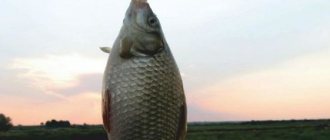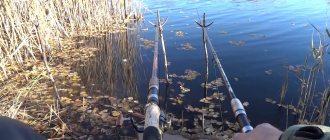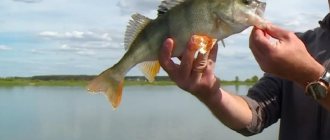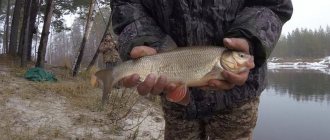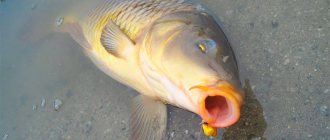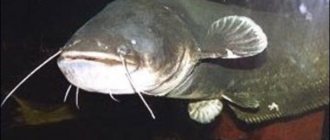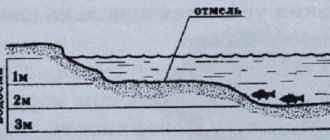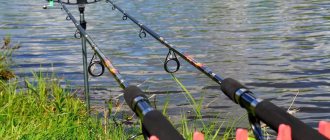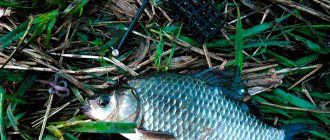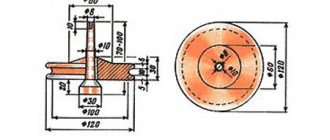Vladimir Klen | October 24, 2021
With modern bottom gear you can purposefully and successfully catch not only peaceful fish, but also predatory ones. This is especially true in terms of hunting for such active schooling fish as perches.
When mastering any new type of equipment, every angler initially has a desire to simply catch fish with it - regardless of the type and size of the latter. However, as you master the gear, acquire skills and experience, you develop the ability to catch not just anything, but specific varieties of fish, sometimes even with given characteristics. Feeder tackle with its widest range of applications is no exception.
Practice convinces us that with this sensitive donkey you can catch absolutely everything, from small bleak to trophy carp or catfish. But, despite this, the feeder is still more often associated with catching fish that are considered non-predatory - bream, roach, silver bream, crucian carp, carp, etc. Less often, people go with him to catch omnivorous fish, such as chubs or, say, barbel. Well, predatory fish - pike, perch, pike perch, asp - are considered the exclusive domain of spinning anglers or those who like to fish with live bait.
Of course, such a division has a basis, but the capabilities of modern equipment, with a competent approach and the availability of appropriate skills, allow us to erase stereotypes. The same bream and carp today are successfully caught with a spinning rod, and perch not only with a float rod, but also with a feeder.
Links
If you look at it, it is not surprising that striped predators are an excellent object for bottom fishing with a feeder. Moreover, one can even give a number of arguments in favor of the argument that they are directly created for feeder fishing - and in some cases, donka will give a head start to other types of equipment in the hunt for striped fish. I will give arguments.
Firstly, these fish live in large numbers and occupy almost all reservoirs and watercourses. They lead a sedentary lifestyle, without making serious migrations, and therefore calculating the places of their concentration is not a problem. Small perches can be easily found near bridges, swimming pools, piers, piles and other structures. Preferring coolness, on hot days they stand under steep banks near flooded bushes, under tree branches hanging over the water, in the shade of aquatic vegetation. Accordingly, the chance of catching them is no less high than the ubiquitous roach. As for the feeder rod itself, in “strong” places it is sometimes preferable to a fishing rod, float or spinning rod, when used in a limited space the number of hooks is quite high.
Secondly, perches are omnivores. It is known that in water bodies rich in benthos, not only juveniles, but also large individuals continue to feed on larvae throughout their lives. By the way, perches aged 4–6 years of life are considered to be pronounced predators, and this despite the fact that perches reach half a kilogram size by 7–8 years.
Thirdly, they are perhaps the most voracious fish. Experts say that the waking phase of well-fed perches coincides with the active phase of hungry ones. Therefore, by properly feeding the fishing point, you can quickly attract the attention of fish and then count on systematic success in catching them.
Fourthly, perch are active throughout the year, and in early spring and autumn they can be successfully caught all day, especially if the weather is cloudy.
And fifthly, it is the feeder from the shore that is the easiest to reach deep-sea areas where perches move for the winter in the fall. And there, in pits and pools, humpback perches are found all year round, leaving them only in the mornings and evenings for a short time in the summer. And on small rivers, perches again accumulate in holes and widenings of the channel, near riffles, waiting for prey carried by the current.
How to catch a freshwater robber
For many centuries, winter perch (and not only it) have been caught by absolutely any means. Thanks to the development of various technologies and skills, fishermen constantly invented some new ways of catching this fish, while increasing their efficiency each time.
People diligently monitored the habits of this species and tried to listen as carefully as possible to its tastes. Thus, the habits of this predator were revealed to man, and this allowed him to learn to predict its movements.
Read here Zherekh - the best baits, lures, effective methods, subtleties and secrets of fishing (120 photos + video)«>
Well, as for today, the twenty-first century offers fishermen to use such products as:
- Types of various spinning rods (for example, twitching or dropshot). The most popular type of fishing;
- Regular bottom tackle. Here you can recall such options as picker, zakidushka or half-bottom. Donke fishing is very common among beginners;
- Float rod;
- Special gear designed for fishing in the cold season. A jig or spinner works well here.
If the fishing process takes place far from the shore and in this place there is a fast current combined with a rocky bottom, then the fish is hunted using fly fishing.
In general, any of the listed methods is good in its own way. The most important thing for a person is to understand which method he likes best.
First meeting
For the first time, while fishing with a feeder, I came across a perch bite, without expecting it. That day, despite all my efforts, neither the bream nor the white bream were active. Having tried different options for changing this position, I finally decided to use bloodworms and chopped worms instead of the bait mixture, except that I clogged the feeder filled with them with porridge on both sides so that the two-component bait would not fall out. I poured such portions into the catching point of the heels - and soon I saw a barely noticeable twitching of the tip. I hooked it carefully and felt a pleasant resistance on the hook. I thought that I still waited for the bream’s reaction, and my prey seemed to match it. True, I thought so until it appeared in front of my eyes - it was not a bream at all that entered the set-up landing net, but a rather large perch.
Such a trophy was somewhat discouraging, but did not look sensational, because in winter not only small perches were regularly and well caught from the ice in this water area, but also humpback whales jumped through. Therefore, considering the success not accidental, I continued fishing. As a result, in a few hours the fish tank was filled with several dozen perch, which were diluted only by a few roaches caught during the period between the striped ones.
Using the feeder on different water bodies, over time I noticed that perch can indeed constitute not only the by-catch, but also the main catch. Moreover, I figured out several places where they are effectively caught from the bottom with enviable consistency and even better than other fish. The collected information allowed us to form the following ideas about the “feeder” perch and the equipment that is optimal for catching it.
Features of the autumn feeder
When planning to go feeder fishing, you need to know its location in advance - it’s a river or a large lake. After all, in shallow water it is difficult to catch a large specimen. On a large area of water, you need to know places with holes, whirlpools, and snags.
It is more common to fish on narrow rivers, but the catches will be small. Fishermen who often go fishing pay their attention to the places where small rivers flow into wide rivers. There are sometimes great depths here, and the fish stand at the tributary in the hope of the food they bring.
In autumn, especially late, the fish choose their winter places. It is especially pleasant to catch bream and roach on the feeder in the fall. These are “classic” fish species; their behavior can be used to judge the bulk of the fish population.
September
The month is already marked by a drop in temperature. The water becomes clear due to the cessation of growth of aquatic plants. The fish begins to prepare for winter. On the borders of reeds and clear water you can also find pike. Later, when small and medium-sized fish move into the depths, the predator follows them. If an angler wants to catch burbot or pike perch, then they need to look for them in snags.
There are still warm days. At such times, you need to look for fish near the shore, near the fallen algae. As the temperature drops, all this water grass still falls to the bottom, and the fish moves to another place. For example, a pike gets hungry in winter and grabs everything. Without particularly choosing lures and bait.
In the fall, feeder fishing is good on medium rivers. Especially in the places where small ones meet large ones. In such places you can hope to catch chub and crucian carp. These fish do not leave their places as the temperature drops.
October
This month is famous for rain and cold winds. The fish goes deeper. But activity is high, and predators continue to eat. Until the very frosts, you can achieve success near reservoirs with steep banks with overhanging trees.
Places in creeks covered with fallen leaves are attractive for fish. There are roach, perch and rudd here. Bream and silver bream are found in the reservoirs. Their place is a riverbed edge, or a flat bottom with stones.
While at the reservoir, the angler must find a channel or hole; this is where fish are usually found. It will probably stand near fallen trees, stones and other obstacles if there is decent depth.
November
A feeder in November, if all fishing rules are followed, can be successful. True, the water temperature drops to +2-+4 degrees, and the activity of the fish decreases. It is located near the wintering pits; only selected bait will help make it take the bait.
The most important thing for feeder fishing at this time of year is choosing a place with the expected fish. For example, bream gathers in large schools and occupies deep places. But within a day, a school of bream can move several kilometers in search of food. Feeder fishing in late autumn can continue until freeze-up.
Snap on striped
I don’t see any point in making special demands on a feeder rod used for catching perches. I focus on fishing conditions: current, wind strength, casting distance, characteristics of the water area, etc. However, the issue of feeder sensitivity is not secondary. The bites of a seemingly predatory perch are most often timid and weakly expressed, so when using a hard tip you can simply not notice them.
But when playing, a striped fish does not always give in without a murmur, so a well-cushioned form and a flexible, sensitive tip will ensure both effective hooking and minimize derailments. By the way, I noticed that several empty bites or gatherings can lead to the cessation of biting. I cannot explain the reason for this phenomenon, but it does not bring pleasure.
If possible, the feeder can generally be replaced with a more “slender”, sensitive and shorter picker, which will simultaneously increase the fishing speed with high casting accuracy, and will also allow you to more quickly change fishing spots in the event of a perch school moving from the original point or even finding a new school.
The best option for transmitting bites is provided by a cord, so I equip the reel with it. A thickness of 0.08 - 0.10 mm is sufficient. However, the disadvantage of the cord is that it reduces the shock-absorbing properties of the equipment. As a result, weak perch lips are often torn by the hook, which can then fall out of the fish’s mouth. This problem is mitigated by the use of a shock leader or insert from a feeder-gum (power-gum) in the equipment. When fishing for perch in lakes at long distances, such options are justified.
Well, when using a picker and casting at short and medium distances, you can use a non-rigid fishing line instead of braid. In this case, additional elements will not be required.
As for the leash, we should not forget that, as a representative of predators, perch is capable of damaging the fishing line with its small teeth. Therefore, a leash 50 - 70 cm long made of fluorocarbon fishing line seems to be the most preferable. Unless, if it is necessary to ensure the slowest, smooth immersion of the bait, which appeals to the perch, you need a regular fishing line, which is half the weight of fluorocarbon.
The last mentioned circumstance is reflected in the type of equipment installation. I prefer to use a Gardner Paternoster or a "helicopter" with two knots. They are the ones who are better than others at registering bites on a fall, while remaining virtually universal. Well, an alternative to a hook can be a jig.
Considering that to attract attention and collect perches at one point, food is used not of plant, but of animal origin - chopped worms, maggots, bloodworms, crushed shells, etc., it is better to select a feeder that either minimizes their loss during immersion (such as a river feeder ), or container type with closed ends and openings in the body. However, at a short fishing distance, the feeder will give way to a bottom sinker, and feeding with this option is done with a slingshot or even by hand.
How to properly catch a predator on a feeder?
When catching predators on a feeder, live bait is most often used as bait, which places special demands on casting gear. Vigorous casting over a long distance will lead to the death of live bait, which will greatly reduce the likelihood of a bite. Therefore, catching predatory fish on a feeder is most often carried out at short distances, especially since they most often come to the coastal zone to feed.
There is no need to rush to hook when there is a bite; it is better to take a short pause and allow the fish to swallow the bait.
Some fishermen tie rigs directly on the line, making knots to limit the movement of the feeder
Landing fish is usually not a problem, except for biting very large specimens of catfish, pike or pike perch.
The principle of catching pike on a predatory feeder
For catching toothy predators, the most effective and practically the only suitable bait is live bait. Widespread fishing in Western Europe with dead fish is explained by the peculiarities of legislation that prohibits the use of live fish as bait.
When making a rig for catching pike on a feeder, it is necessary to take into account that due to the peculiarities of its anatomy, it is more convenient for a pike to attack prey located above it or at the same level. Thus, it is desirable that the live bait swims at some distance from the bottom. This can be achieved by including a small float made of cork or foam into the equipment.
In the case of targeted pike fishing, a metal leash is used in the equipment. If a pike bite is possible when fishing for other fish, it is better to stick with a fluorocarbon leash.
The most effective way is with live bait
The principle of catching pike perch on a predatory feeder
Pike perch is often caught as bycatch when fishing for bream or roach, especially in spring. With a purposeful feeder, pike perch can be caught using live bait, dead fish, or “cutting” - narrow strips of fish fillets, cut off with skin and scales. It is desirable that there is a fin on the strip. As live bait, it is better to use fish with a narrow body - gudgeon or goby. Bleak, being the favorite food of pike perch, dies too quickly on the hook and requires frequent replacement.
Installation for catching pike perch is not complicated - a sliding sinker or feeder of a weight suitable for fishing conditions, a swivel and a leash made of monofilament or fluorocarbon 0.2-0.3 mm and 50-70 cm long. The hook must be very sharp, given the hard mouth of the pike perch.
The principle of catching perch on a predatory feeder
Perch, being a pronounced predator, feeds not only on fish, but also on various aquatic invertebrates, so it can be caught using both live bait and a classic feeder.
Live bait rigs for perch differ from rigs for pike and pike perch in that they have a thinner fishing line and leader, as well as a smaller hook.
Catching minke whales with a feeder is carried out using baits of animal origin - a worm, bloodworms, a leech, and less often maggots.
It is important to use a large number of components of animal origin in bait, as well as the use of flavors with the smell of shrimp, mussels, and bloodworms. You can use fishmeal as a budget-friendly substitute for flavorings.
Groundbait and lures
Above, I already mentioned a successful option for feeding perches. This is the path I am following. Along with the animal component, I add to the complementary food not only the standard nutrient mixture, but also soil mixed with it, which creates a turbidity in the water that is attractive to perches - after all, the task of bait is to attract the attention of perches to the place where the equipment is immersed. I don’t want to keep them with a large amount of nutrients. If the perches approach, they will certainly react to the bait. Therefore, especially when fishing in shallow waters, after pouring several portions of food from a large feeder into the fishing area, I subsequently replace it with the smallest possible feeder. It minimizes the noise that frightens perches, makes the equipment more delicate, simplifies working with it, and reduces the number of idle hooks.
The classic feeder trio of animal baits - bloodworms, worms and maggots - also leads when catching perches from the bottom. They can compete with leeches and lamprey larvae (spindles). It’s good when there are, if not all of the specified types, but at least several of them. I know lakes where perches are caught exclusively with bloodworms, but there are also places where, contrary to logic, they give priority not even to it or the worm, but to maggots. Moreover, the larger the bait, the higher the chance of catching a large individual. Therefore, a sandwich constructed from several types of moving bait will come in handy.
Treating the bait with flavorings gives a good attractive effect. Moreover, as practice shows, the appetite of perches is stimulated not only by dips with animal or fish scents (“Predatory fish”, “Perch”, “Squid”, etc.), but also by vegetable ones (vanilla, hemp, cinnamon, etc.). I do not exclude that the answer to this phenomenon lies both in the relative constancy of the use of certain odor baits by fishermen on a particular body of water, and in the novelty of the odor. I consider perch and crucian carp to be the most curious inhabitants of the depths.
The option of baiting a fry on a hook is not excluded, but this fishing is still from a different story, so I see no reason to pay attention to it when fishing with a feeder. It is more important to note that after casting the equipment, you should wait until the bait sinks to the bottom. If there is no bite on the fall, you should not passively look at the quivertip. Catching perch requires active action on the part of the feeder himself. Moreover, it is better to hold the rod in your hand and perform short stretches with it. In this case, the bait moves along the bottom, simultaneously raising turbidity and exciting the perches looking at it. It turns out something like wiring a “balda”.
Considering that every year manufacturers of artificial fishing baits increase their varieties, at the same time imparting a smell and achieving maximum similarity to the prototypes, I had the intention of trying out such baits in feeder fishing. And specifically with a focus on perches, because I believe it is impossible to do without setting imitations into motion. However, this will be a completely different story.
